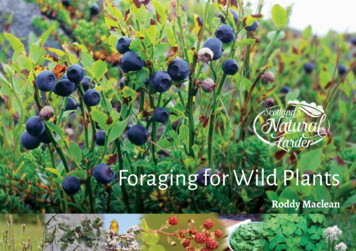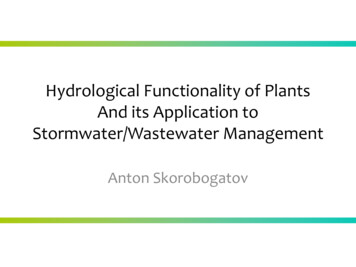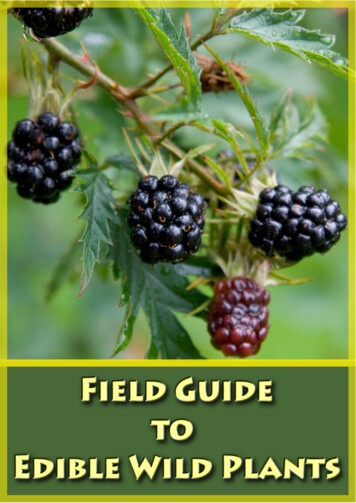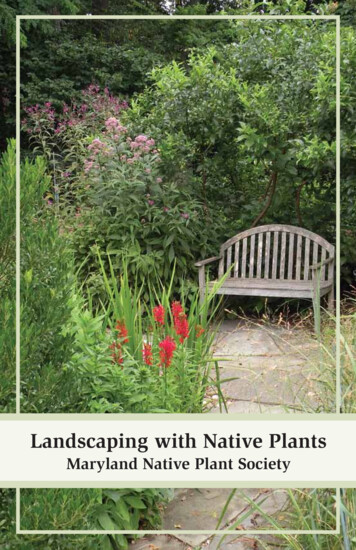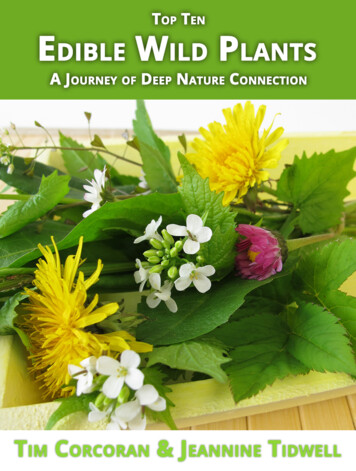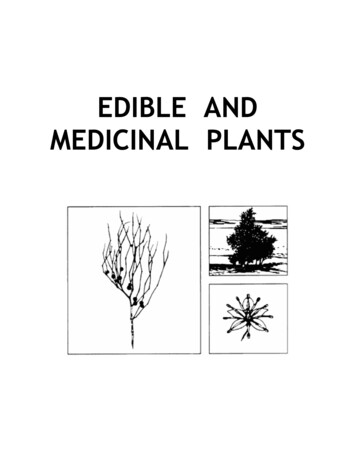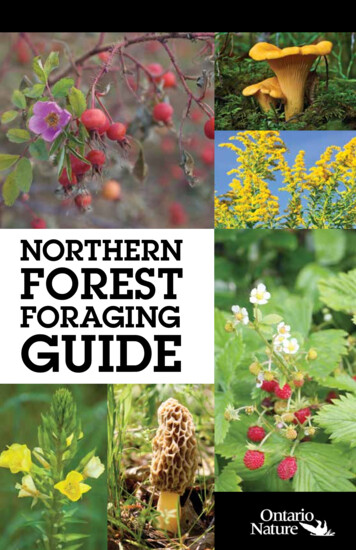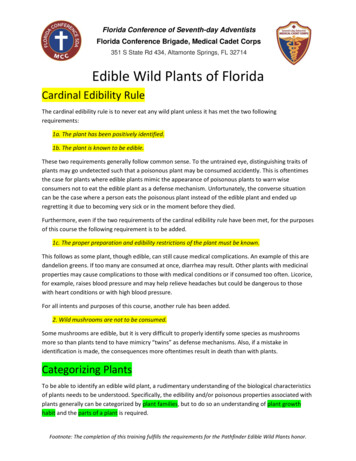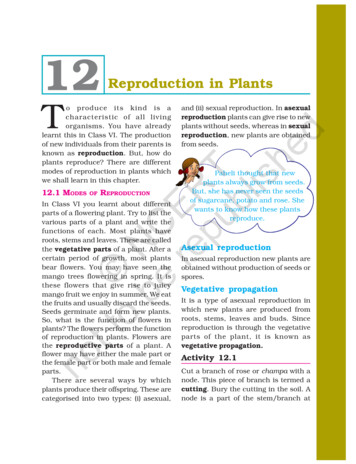
Transcription
12Reproduction in Plantsand (ii) sexual reproduction. In asexualreproduction plants can give rise to newplants without seeds, whereas in sexualreproduction, new plants are obtainedfrom seeds. o Nbe Cre ERpu TblishedTo produce its kind is acharacteristic of all livingorganisms. You have alreadylearnt this in Class VI. The productionof new individuals from their parents isknown as reproduction. But, how doplants reproduce? There are differentmodes of reproduction in plants whichwe shall learn in this chapter.12.1 MODESOFREPRODUCTIONnottIn Class VI you learnt about differentparts of a flowering plant. Try to list thevarious parts of a plant and write thefunctions of each. Most plants haveroots, stems and leaves. These are calledthe vegetative parts of a plant. After acertain period of growth, most plantsbear flowers. You may have seen themango trees flowering in spring. It isthese flowers that give rise to juicymango fruit we enjoy in summer. We eatthe fruits and usually discard the seeds.Seeds germinate and form new plants.So, what is the function of flowers inplants? The flowers perform the functionof reproduction in plants. Flowers arethe reproductive parts of a plant. Aflower may have either the male part orthe female part or both male and femaleparts.There are several ways by whichplants produce their offspring. These arecategorised into two types: (i) asexual,Paheli thought that newplants always grow from seeds.But, she has never seen the seedsof sugarcane, potato and rose. Shewants to know how these plantsreproduce.Asexual reproductionIn asexual reproduction new plants areobtained without production of seeds orspores.Vegetative propagationIt is a type of asexual reproduction inwhich new plants are produced fromroots, stems, leaves and buds. Sincereproduction is through the vegetativeparts of the plant, it is known asvegetative propagation.Activity 12.1Cut a branch of rose or champa with anode. This piece of branch is termed acutting. Bury the cutting in the soil. Anode is a part of the stem/branch at
Eyesedwhich a leaf arises (Fig. 12.1). Water thecutting every day and observe itsgrowth. Observe and record the numberof days taken for roots to come out andnew leaves to arise. Try the same activityby growing money plant in a jar of waterand record your observations.Node o Nbe Cre ERpu TblishFig. 12.2 Potato plant sprouting from an ‘eye’of a potato, each with an eye and burythem in the soil. Water the piecesregularly for a few days and observetheir progress. What do you find?Bud inthe axilFig. 12.1 Stem-cutting of rosenottYou must have seen flower budsdeveloping into flowers. Apart fromflower buds, there are buds in the axil(point of attachment of the leaf at thenode) of leaves which develop intoshoots. These buds are called vegetativebuds (Fig. 12.2). A bud consists of ashort stem around which immatureoverlapping leaves are folded. Thevegetative buds can also give rise to newplants.Activity 12.2Take a fresh potato. Observe the scarson it with the help of a magnifying glass.You may find bud(s) in them. These scarsare also called “eyes”. Cut a few pieces134Fig. 12.3 Ginger with new plants sproutingfrom itLikewise you can also grow ginger(Fig. 12.3) or turmeric.Bryophyllum (sprout leaf plant) hasbuds in the margins of leaves (Fig. 12.4).If a leaf of this plant falls on a moistsoil, each bud can give rise to a newplant.SCIENCE
multiply every few hours if sufficientnutrients are made available to them.Remember that yeast is a single-celledorganism. Let us see how they reproduce?Fig. 12.4 Leaf of Bryophyllum with buds in themargin(To be demonstrated by the teacher)Take a piece of yeast cake or yeastpowder from a bakery or a chemist shop.Take a pinch of yeast and place it in acontainer with some water. Add aspoonful of sugar and shake to dissolveit. Keep it in the warm part of a room.After an hour, put a drop of this liquidon a glass slide and observe under amicroscope. What do you observe? Youmay see the formation of new yeast cells(Fig. 12.5). o Nbe Cre ERpu TblishThe roots of some plants can alsogive rise to new plants. Sweet potato anddahlia are examples.Plants such as cacti produce newplants when their parts get detachedfrom the main plant body. Eachdetached part can grow into a newplant.Activity 12.3edNew plantsBoojho wants to know ifthere is any advantage ofvegetative propagation.nottPlants produced by vegetativepropagation take less time to grow andbear flowers and fruits earlier than thoseproduced from seeds. The new plantsare exact copies of the parent plant, asthey are produced from a single parent.Later in this chapter you will learnthat plants produced by sexualreproduction have characters of both theparents. Plants produce seeds as a resultof sexual reproduction.BuddingYou have already learnt about the tinyorganisms like yeast can be seen onlyunder a microscope. These grow andREPRODUCTION IN PLANTSDeveloping budYeast cellChain of budsNew budFig. 12.5 Reproduction in yeast by buddingThe small bulb-like projectioncoming out from the yeast cell is calleda bud. The bud gradually grows andgets detached from the parent cell andforms a new yeast cell. The new yeastcell grows, matures and produces moreyeast cells. Sometimes, another budarises from the bud forming a chain ofbuds. If this process continues, a largenumber of yeast cells are produced in ashort time.135
Sori(Spore formingbodies) o Nbe Cre ERpu TblishYou might have seen slimy greenpatches in ponds, or in other stagnantwater bodies. These are the algae. Whenwater and nutrients are available algaegrow and multiply rapidly byfragmentation. An alga breaks up intotwo or more fragments. These fragmentsor pieces grow into new individuals(Fig. 12.6). This process continues andthey cover a large area in a short periodof time.edFragmentationFig. 12.8 Reproduction through spore formationin fernFig. 12.6 Fragmentation in spirogyra (an alga)Spore formationIn Chapter 1 you learnt that the fungion a bread piece grow from spores whichare present in the air. Repeat Activity1.2. Observe the spores in the cottonSporangiumnoHyphattSporesFig. 12.7 Reproduction through spore formationin fungus136like mesh on the bread. When sporesare released they keep floating in theair. As they are very light they can coverlong distances.The spores are asexual reproductivebodies. Each spore is covered by ahard protective coat to withstandunfavourable conditions such as hightemperature and low humidity. Sothey can survive for a long time. Underfavourable conditions, a sporegerminates and develops into a newindividual. Plants such as moss andferns (Fig. 12.8) also reproduce bymeans of spores.12.2 SEXUAL REPRODUCTIONYou have learnt earlier the structure ofa flower. You know that the flowers arethe reproductive parts of a plant. Thestamens are the male reproductive partand the pistil is the female reproductivepart (Fig. 12.9).SCIENCE
o Nbe Cre ERpu TblishTake a mustard/china rose/petuniaflower and separate its reproductiveparts. Study the various parts of astamen and pistil.The flowers which contain eitheronly the pistil or only the stamens arecalled unisexual flowers. The flowerswhich contain both stamens and pistilare called bisexual flowers. Corn,papaya and cucumber produceunisexual flowers, whereas mustard,rose and petunia have bisexual flowers.Boojho wants to know how themale gamete in the pollen grainreaches the female gamete presentin the ovule.AntherFilamentPollinationGenerally pollen grains have a toughprotective coat which prevents themfrom drying up. Since pollen grains arelight, they can be carried by wind or(a) StamenStigmaBoth the male and the female unisexualflowers may be present in the same plantor in different plants.Could you identify the anther andthe filament of a stamen? [Fig. 12.9 (a)].Anther contains pollen grains whichproduce male gametes. A pistil consistsof stigma, style and ovary. The ovarycontains one or more ovules. Thefemale gamete or the egg is formed inan ovule [Fig. 12.9 (b)]. In sexualreproduction a male and a femalegamete fuse to form a zygote.edActivity ) PistilFig. 12.9 Reproductive partsREPRODUCTION IN PLANTS(a) Self-pollination(b) Cross-pollinationFig. 12.10 Pollination in flower137
o Nbe Cre ERpu Tblishwater. Insects visit flowers and carryaway pollen on their bodies. Some ofthe pollen lands on the stigma of a flowerof the same kind. The transfer of pollenfrom the anther to the stigma of a floweris called pollination. If the pollen landson the stigma of the same flower it iscalled self-pollination. When the pollenof a flower lands on the stigma of anotherflower of the same plant, or that of adifferent plant of the same kind, it iscalled cross-pollination [Fig. 12.10 (a)and (b)].edBoojho wants to know whyflowers are generally so colourfuland fragrant. Is it to attractinsects?Pollen grain (germinating)Pollen tubettZygoteformationOvumno(a)(b)Fig. 12.11 Fertilisation (Zygote formation)FertilisationThe cell which results after fusion ofthe gametes is called a zygote. Theprocess of fusion of male and female138(a)(b)Fig. 12.12 (a) Section of an apple, (b) Almondgametes (to form a zygote) is calledfertilisation (Fig. 12.11). The zygotedevelops into an embryo.12.3 FRUITSANDSEED FORMATIONAfter fertilisation, the ovary grows intoa fruit and other parts of the flower falloff. The fruit is the ripened ovary. Theseeds develop from the ovules. The seedcontains an embryo enclosed in aprotective seed coat.Some fruits are fleshy and juicy suchas mango, apple and orange. Some fruitsare hard like almonds and walnuts[Fig. 12.12 (a) and (b)].12.4 SEED DISPERSALIn nature same kind of plants grow atdifferent places. This happens becauseseeds are dispersed to different places.Sometimes after a walk through a forestor a field or a park, you may have foundseeds or fruits sticking to your clothes.SCIENCE
ed(b)], light seeds of grasses or hairy seedsof aak (Madar) and hairy fruit ofsunflower [Fig. 12.14 (a), (b)], get blownoff with the wind to far away places.Some seeds are dispersed by water. Thesefruits or seeds usually develop floatingability in the form of spongy or fibrousouter coat as in coconut. Some seedsare dispersed by animals, especiallyspiny seeds with hooks which getattached to the bodies of animals andare carried to distant places. Examplesare Xanthium (Fig. 12.15) and Urena.Some seeds are dispersed when thefruits burst with sudden jerks. The seedsare scattered far from the parent plant.This happens in the case of castor andbalsam. o Nbe Cre ERpu TblishDid you try to observe how these seedswere clinging to your clothes?What do you think will happen if allseeds of a plant were to fall at the sameplace and grow there? There would besevere competition for sunlight, water,minerals and space. As a result the seedswould not grow into healthy plants.Plants benefit by seed dispersal. Itprevents competition between the plantand its own seedlings for sunlight, waterand minerals. It also enables the plantsto invade new habitats for widerdistribution.Seeds and fruits of plants are carriedaway by wind, water and animals.Winged seeds such as those ofdrumstick and maple [Fig. 12.13 (a) andSeedWing(a)(a)(b)Fig. 12.14 (a) The hairy fruit of sunflower and(b) hairy seed of madar (aak)nott(b)Fig. 12.13 Seeds of (a) drumstick and(b) mapleFig. 12.15 XanthiumREPRODUCTION IN PLANTS139
KeywordsSexual reproductionSporeSporangiumVegetative propagationZygoteedHyphaOvulePollen grainPollen tubePollinationSeed dispersal o Nbe Cre ERpu TblishAsexual nGametesWhat you have learnt tt All organisms multiply or reproduce their own kind.In plants there are two modes of reproduction, asexual and sexual.There are several methods of asexual reproduction such asfragmentation, budding, spore formation and vegetative propagation.Sexual reproduction involves the fusion of male and female gametes.In vegetative propagation new plants are produced from differentvegetative parts such as leaves, stems and roots.Flower is the reproductive part of a plant.A flower may be unisexual with either the male or the female reproductiveparts.A bisexual flower has both the male and the female reproductive parts.The male gametes are found inside the pollen grains and female gametesare found in the ovule.Pollination is the process of transfer of pollen grains from the anther ofone flower to the stigma of the same or another flower.Pollination is of two types, self-pollination and cross-pollination. Inself-pollination, pollen grains are transferred from the anther to thestigma of the same flower. In cross-pollination, pollen grains aretransferred from the anther of one flower to the stigma of another flowerof the same kind.Pollination takes place in plants with the help of wind, water and insects.The fusion of male and female gametes is called fertilisation.Fertilised egg is called zygote. Zygote develops into an embryo.Fruit is the mature ovary whereas ovule develops into a seed, whichcontains the developing embryo.Seed dispersal is aided by wind, water and animals.Seed dispersal helps the plants to (i) prevent overcrowding, (ii) avoidcompetition for sunlight, water and minerals and (iii) invade new habitats. no 140SCIENCE
Exercises1. Fill in the blanks:Production of new individuals from the vegetative part of parent iscalled .(b)A flower may have either male or female reproductive parts. Sucha flower is called .(c)The transfer of pollen grains from the anther to the stigma of thesame or of another flower of the same kind is known as.(d)The fusion of male and female gametes is termed as .(e)Seed dispersal takes place by means of ,and . o Nbe Cre ERpu Tblished(a)2. Describe the different methods of asexual reproduction. Give examples.3. Explain what you understand by sexual reproduction.4. State the main difference between asexual and sexual reproduction.5. Sketch the reproductive parts of a flower.6. Explain the difference between self-pollination and cross-pollination.7. How does the process of fertilisation take place in flowers?8. Describe the various ways by which seeds are dispersed.9. Match items in Column I with those in Column II:Column IColumn i)Yeast(d)Wings(iv)Bread mould(e)Spores(v)(vi)MaplePotatoRosett10. Tick (9) the correct answer:The reproductive part of a plant is theno(a)(b)(i)(ii) stem(iii) root(iv) flowerThe process of fusion of the male and the female gametes is called(i)(iii)REPRODUCTION IN (iv)seed formation141
(d)Mature ovary forms the(i)seed(ii)stamen(iii)pistil(iv)fruitA spore producing plant is(i)(iii)(ii)bread mouldpotato(iv)gingerBryophyllum can reproduce by its(i)stem(ii)leaves(iii)roots(iv)flower o Nbe Cre ERpu Tblish(e)roseed(c)Extended Learning — Activities and Projects1. Make your own cactus garden by collecting pieces cut from differentkinds of cacti. Grow the variety in one single flat container or inseparate pots.2. Visit a fruit market and collect as many local fruits as possible. If manyfruits are not available, you can collect tomatoes and cucumbers (theseare fruits, though we use them as vegetables). Make drawings of thedifferent fruits. Split the fruits and examine the seeds within. Look forany special characteristics in the fruits and their seeds. If possible visitthe rsal.pdfYou can visit a library also to learn about this.3. Think of ten different fruit-bearing plants. Remember that manyvegetables are also fruits of the plants. Discuss with your teacher,parents, farmers, fruit growers and agricultural experts (if availablenearby) and find out the manner of their dispersal. Present your datain the form of a table as shown below:S. No.Name of fruit- Agent through whichbearing plantseeds are dispersedPart of or seed whichhelps in dispersaltt1.2.3.no4. Suppose there is one member of a particular kind of organism in aculture dish, which doubles itself in one hour through asexualreproduction. Work out the number of members of that kind of organismwhich will be present in the culture dish after ten hours. Such a colonyof individuals arising from one parent is called a “clone”.You can read more on the following website:www.edumedia-sciences.com/a437 l2-blog-call.html142SCIENCE
Take a piece of yeast cake or yeast powder from a bakery or a chemist shop. Take a pinch of yeast and place it in a container with some water. Add a spoonful of sugar and shake to dissolve it. Keep it in the warm


